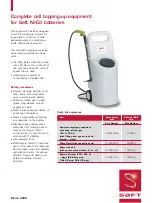
4.3. VE.Smart Networking
VE.Smart Networking
enables Bluetooth connectivity and communication between multiple Victron products.
This powerful feature enables chargers to receive accurate battery voltage (Volt-sense), charge current (Current-sense) and
battery temperature (Temp-sense) data from a compatible battery monitor (such as a BMV, SmartShunt, Smart Battery Sense or
VE.Bus Smart Dongle) and/or multiple chargers to operate in unison with synchronised charging to further enhance the charge
cycle.
4.3.1. Voltage, temperature and current sense
Voltage Sense
uses battery voltage data that is accurately measured directly at the battery terminals (or very close) and provides
it to the charger, the charger then uses this voltage data to dynamically increase the output voltage and precisely compensate for
voltage drop in the cabling and connections between the charger and battery.
This enables the battery to be charged with the exact voltage as configured in the charger, instead of a lower voltage due to
voltage drop in the cabling and connections.
Voltage drop is proportional to the charge current and cabling/connection resistance (V=IxR), so voltage drop will vary during a
charge cycle and can be quite significant when charging at higher charge currents through cabling and connections with higher
than optimal resistance; in this scenario voltage sense will be particularly beneficial.
Note that voltage sense does
not
allow inadequately rated cabling or connections to be used, for reliable and safe operation
cabling and connections must always be rated to carry the maximum current (including the fault current required to blow the
fuse/trip the breaker) in the particular installation conditions.
Temperature Sense
uses battery temperature data that is accurately measured directly at a battery terminal or on the battery
body and provides it to the charger, the charger then uses this temperature data to dynamically compensate the charge voltage
(decrease or increase) according to the specified temperature coefficient (X mV/°C).
The optimal charge voltage of a lead acid based battery varies inversely with battery temperature with the nominal charge voltage
specified at 25°C; automatic temperature-based charge voltage compensation avoids the need for manual charge voltage setting
adjustments in hot or cold environments.
For lithium batteries the optimal charge voltage remains constant under all normal operating temperatures, however lithium
batteries can be permanently damaged if charged in cold conditions; in this case the temperature sense data can be used to
automatically disable charging in cold conditions (typically <5°C).
Current Sense
uses battery current data that is measured by the battery monitor shunt (requires a BMV or SmartShunt) and
provides it to the charger, the charger then references this current data (as opposed to the charger output current) for the tail
current setting.
The tail current setting references the diminishing level of charge current (typical at the end of a full charge cycle) in relation to the
trigger threshold to determine when the battery is fully charged and consequently when the absorption stage can be ended (prior
to the absorption stage time limit being reached). The use of tail current to end absorption stage is a highly effective and common
method used to properly charge lead acid based batteries.
In order to end the absorption phase at the correct point, it is important that the true current flow into the battery is referenced
in relation to the tail current threshold, rather than the charger output current which may be significantly higher; if any loads
are powered while charging a portion of the charger output current will be flowing directly to the loads, making the tail current
condition more difficult or impossible to meet without current sense.
Multiple compatible chargers can be added to a common VE.Smart network and receive voltage, temperature and/or current
sense data from the same battery monitor. Once multiple compatible chargers are in a common VE.Smart network their charge
algorithms will also be syncronised, refer to the 'Synchronised charging' section for more information.
4.3.2. Synchronised charging
Synchronised charging
capability enables multiple compatible chargers to be combined together in a common VE.Smart
network, allowing the chargers to operate in unison as if they were one large charger.
The chargers will synchronise the charge algorithm between themselves with no further hardware or physical connections
required, and simultaneously change charge states.
Synchronised charging works by systematically prioritising all chargers and assigning one as the 'master', this charger then
controls the charge stage of all other 'slave' chargers. In case the initial 'master' is disconnected from the VE.Smart Network
for any reason (out of Bluetooth range for example), another charger will be systematically reassigned as the 'master' and take
over control; this can also be reversed if communication with the initial 'master' (that has a higher priority) is re-established. The
'master' charger can not be manually selected.
Synchronised charging does not regulate or equalise the current output of multiple chargers, each charger still has total control
over it's own current output. Accordingly, current output variation between multiple chargers is normal (dependent on cable
resistance and other factors) and a total system current output limit cannot be configured. For systems where a total system
current output limit is important, consider using a GX device with DVCC instead.
Phoenix Smart IP43 Charger
Page 9
Operation












































